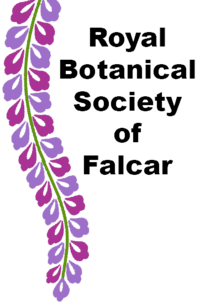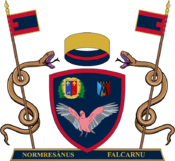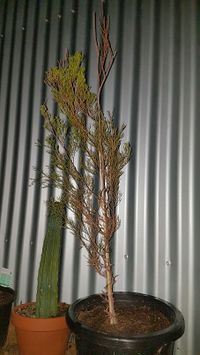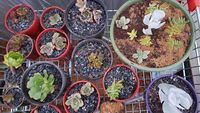Royal Botanical Society of Falcar
 Logo of the Society (2017 -) representing the most common flower of the former state of The Kanes Wisteria sinensis | |
| Crown Corporation of Falcar | |
| Predecessor | none, some duties were previously invested in The Royal Society of Oak (defunct) |
| Founded | 30 June 2016 |
| Founder | First King of Falcar Todd Leon |
| Headquarters | , |
Area served | Arbonia, The Kanes (former) |
Key people | Wildcraft-General |
| Services | Performs duties relating to the classification of fauna & flora; wildcrafting duties; weather forecasting; regulation of pest-control and to maintain the Royal Botanical Garden of Falcar and the National Parks of Falcar |
| 15.01% of state revenue (2019 Budget) | |
| Part of a series on |
| The Kingdom of Falcar |
|---|
 |
| As maintained by the Postmaster-General of Falcar |
The Royal Botanical Corporation currently stylised as The Royal Botanical Society of Falcar is the government department representing the Flora (plant life) and Fauna (animal life) within the Kingdom of Falcar. This role includes the maintenance of national parks as well as maintaining the collections of the Royal Botanic Garden of Falcar. The corporation was officially established through charter on the 30th of June 2016, as part of the Flora Act 2016.
Duties
Under the Flora Act 2016 Sec A Part II the Duties of the Company and Wildlife-General are;
1) To maintain the gardens of Falcar; 2) To catalogue species present within Falcar of Plant, Animal and Fungi; 3) To monitor weather forecasts; 4) To introduce and erradicate Plant, Animal and Fungi Species from Falcar; 5) To harvest pods, seeds and other items from Falcar; 6) To regulate pest control within Falcar.
Prohibited Species
As the Flora Act gives the powers to introduce & erradicate as well as powers to regulate pest control to the company, the wildcraft-general publishes a List of Prohibited Species at his discretion, importation or introduction of a species listed into any Falcarian area is an offence (Flora Act 2016 Sec B Part II)
Prohibited Species List (2017)
- All species within the genus Rubus commonly known as Bramble (Raspberries, Blackberries..) is completely prohibited and must be destroyed if found.
- All species within the genus Opuntia require a permit, with some species such as Opuntia stricta being completely prohibited.
- Atropa belladonna or Deadly Nightshade is completely prohibited and must be destroyed if found
- Introduction of any species or cultivar in the genus Rosa that is not already present within the National Parks of Falcar is prohibited without a permit.
- Possession of a Domestic Cat requires a feline importation permit, as well as a feline handler permit. Neither of which are currently administered.
Plants of Cultural Significance
Some of the plants within the nation of Falcar are designated as Culturally Significant. It is a serious offence under the Flora Act 2016 (Sect. B Part I & III) to injure, destroy, remove from the nation or somehow negatively impact on a Culturally Significant Tree.
Pine of The Kanes

The Pine of The Kanes was officially designated as culturally important. It was used as an example of wildlife from an island claim previously made by the nation. It comprised part of the monarchal collections of the Royal Botanical Garden and was listed as at risk during the 2017 Falcarian Census. The Species, Callitris preissii was the only plant within Falcar in the Genus Callitris. It was later reported to have died during the extreme heat of the 2018 summer.
The tree was moved after the passing of the Proclamation Act 2017 and resided within Inner and Outer Falcar at the time of it's demise
The Royal Botanical Garden
The Royal Botanical Garden of Falcar is a botanical collection situated within Arbonia, officially dedicated to the collecting, cultivating and exhibiting of plants & fungi.

The original collection originated from monarchal collections, comprising of few succulents and common herbs; it has since performed independently of the monarch and currently 64% of the botanical collection is owned by the Royal Botanical Corporation, rather than The Monarch or other third party lenders.
Species List
As of the 2017 Flora & Fauna Census, the Royal Botanical Garden comprises of the following plants;
The most common genus is Aeonium Succulents with 7 separate species.
- Aeonium arboretum (most common succulent)
- Aeonium decorum
- Aeonium gomerense
- Aeonium leucoblepharum
- Aeonium x poldark
- Aeonium undulatum
- Aeonium valverdense
- Agave americana
- Agave attenuata
- Aloe jucunda
- Aloe vera
- Aloe vera var. chinensis
- Artemisia arborescens
- Callitris Preissii (Tree of Cultural Importance) (at risk)
- Citrullus lanatus var. lanatus
- Citrus limon
- Cotyledon undulata
- Crassula arborescens ssp. undulatifolia
- Crassula ovata
- Crassula ovata var. Gollum & Hobbit
- Crassula ovata var. Money Maker
- Echeveria prolifica
- Echinocactus platyacanthus
- Echinopsis candicans
- Echinopsis pachanoi
- Ficus carica var. Brown Turkey (at risk)
- Hedera helix
- Hedera helix var. Variegata
- Kalanchoe scapigera
- Kalanchoe thyrsiflora
- Lactuca virosa (declared pest)
- Lavandula angustifolia (at risk)
- Oxalis pes-caprae
- Pachyphytum bracteosum
- Pachyphytum oviferum (at risk)
- Pteridium esculentum
- Rosa x alba (declared plant)
- Sedum compactum
- Sedum morganianum
- Sedum x rubrotinctum
- Sinocrassula yunnanensis
- Sonchus oleraceus (declared pest)
- Taraxacum officinale (declared pest)
- Urtica dioica (declared pest)
- Wisteria sinensis (most common plant)
- Zoysia macrantha (most common grass)
- Also 3 unidentified species;